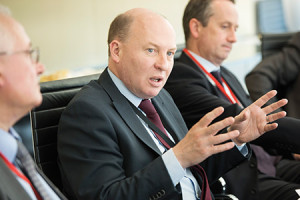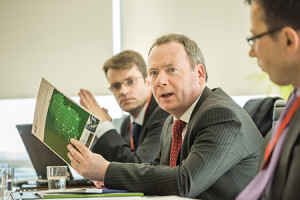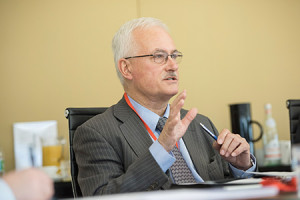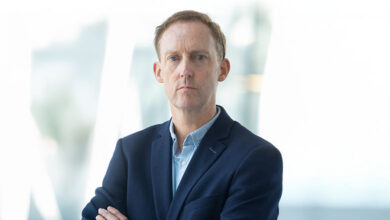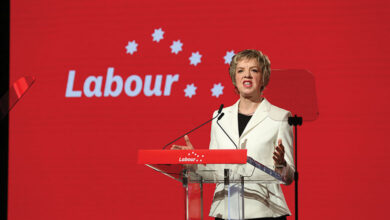Smart grids: Ireland’s energy opportunity
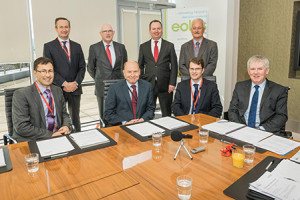 EirGrid hosted a round table discussion on the development of smart grids and how this promising technology will revolutionise the energy sector and offer employment opportunities.
EirGrid hosted a round table discussion on the development of smart grids and how this promising technology will revolutionise the energy sector and offer employment opportunities.
What role will smart grids play in delivering a sustainable energy future?
David Lee
Smart grids are a key enabler of a fundamental change in the value chain for the energy industry. Traditionally, the energy industry has had a very centralised model of generation that has remained largely unaltered since Edison’s time. We’re now moving to a model which is characterised by a two-way flow of energy and information between producers and consumers with consumers no longer simply being passive recipients of power. The smart grid is a fundamental enabler of this new value chain by providing the necessary flexibility and reliability in the networks.
Brian Motherway
If sustainability is about using the right resources intelligently and efficiently, and having the right deployment of the resources and services that people need, the fact that you can make an intelligent grid makes it possible to eliminate waste and improve control, data and understanding.
What it opens up is indeterminate – in terms of making our energy system more sustainable and meeting consumers’ and citizens’ needs better. It’s a really exciting opportunity and the question is how to ‘play at the table’ in determining the right choices and opportunities for Ireland, and exploiting them correctly.
One caveat. We’re too focused on electricity – which is a fifth of our energy system – so two questions arise: “Is it not relevant to the other four-fifths or can we make it relevant e.g. in home heating and transport? Can the exciting forward momentum of smart grids bring benefits beyond the traditional domain of how we supply and use electricity at present?”
Muiris Flynn
Much of the energy used in the economy is used for space heating and water heating in homes and commercial buildings. We see the smart grid as an enabler to make the link between the power system and the home. This will enable those technologies that deliver demand side flexibility, ultimately opening up opportunities for the benefit of the consumer and allowing them to participate in more flexible energy markets. It is also ultimately a means to facilitate greater renewable generation.
Bob Hanna
Smart grids transfer the balance of power to the consumer from the producer but they also allow a more centralised control which can optimise things for everybody. The European Smart Grid Task Force defines the smart grid as an electricity network that can cost-effectively integrate the behaviours and actions of all users connected to it – generators, consumers and those that do both – in order to ensure an economically efficient sustainable power system with low losses and high levels of quality, security of supply and safety.
Everybody who handles electricity is connected in a way that maybe we didn’t understand before. It’s hugely exciting and we’re now thinking in terms of connected systems instead of isolated technologies. The future’s bright for smart grids.
Fintan Slye
There is a paradigm shift in the business model and the value chain underlying the electricity system and indeed the energy system in its broadest sense. Smart grids do a number of things. They allow us, EirGrid as the system operator, to manage the increased complexity associated with moving towards an electricity system where 40 per cent of the demand is met by renewables and most of that from a variable source, wind.
The technology definitely opens up demand side participation, empowering consumers of all sizes to participate in a market. Additionally, it gives customers greater control over their costs, what type of power they use, and when they use it.
Additionally, it allows us to maximise the use of the network and assets that are there on the ground, which has benefits for consumers in terms of lower costs and for society and the environment i.e. not having to build as much new infrastructure and allowing us to get more out of what’s there.
We need to extend the concept of smart grids into heat and transport and there are huge opportunities in using electricity to deliver more sustainable solutions.
Leo Clancy
The amount of wind that will be on the grid by 2020 has the potential to be a destabilising influence if smart grids aren’t implemented properly. Optimising imports of energy product by using our wind base is a massive opportunity. On the consumer innovation side, it will be possible to provide incentives and disincentives depending on the availability of wind power and also other sources.
John Murphy
From an enterprise development perspective, our primary challenge is to reduce energy costs while delivering on security of supply and environmental sustainability. Energy costs are a large component, particularly in food and drink, life sciences, ICT and construction materials. Many of these are large and important regional employers.
Our margins are low because we’re in an intensely competitive global economy so anything that can help to optimise these resources and reduce costs is important. We also want to provide significant opportunities for firms – whether they are indigenous or multi-national – which can assist in developing smart grid technology and sell those services abroad.
How can Ireland be at the leading edge in innovation in smart grids?
Brian Motherway
The key advantage Ireland has is its smaller scale and we also have a more human way of doing things. For example, most of the organisations represented here today have co-operated on the Smart Grid Roadmap which was launched by the Minister in Washington DC. It is possible for all the key actors to sit around a table engage and develop a strategy. That’s important because smart grid is diverse and diffuse and no one organisation can deliver it. The key to success internationally will be a public system of regulation and policy that can innovate at the same pace as that of the private technology innovators.
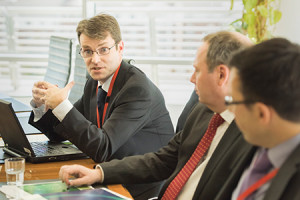
Fintan Slye
It will mean bringing other actors into a space that was originally dominated by one utility to technology players like IBM and Glen Dimplex. The end game will be different as these other players come in. There is a huge opportunity around the ability to build something that we can sell and not just in terms of the energy system in Ireland but in terms of products and services that can be sold abroad.
Under our Demonstration Project Initiative, EirGrid have just commissioned a new DSM project that is a collaboration between ourselves, Electricity Exchange, Intel, Maxim Integrated, and ResourceKraft. This type of collaborative work is exactly what we need to move the sector forward and position Ireland as a world leader in this space.
David Lee
Ireland has a good international reputation in terms of being at the forefront on innovation in smart grids. That was part of the reason why IBM choose to locate a research centre in Ireland.
This is a complex problem that cuts across traditional boundaries and the range of capabilities needs to be framed in the right regulatory environment that supports and rewards innovation from organisations that have traditionally taken a conservative approach to investment.
Bob Hanna
Europe recognises that we are already at the leading edge in smart grids. I have seen all the projects coming forward for the projects of common interest list and the Irish project is the best by a long way in terms of innovation and the connectedness of the participants. It is now a question of addressing the barriers, including regulatory barriers, and we will have to work with some organisations that have previously been responsive rather than proactive in this area.
What are the benefits of smart grids for Ireland?
John Murphy
In economic terms, energy costs are important but a lot of the costs are fuel costs which are outside our control as we are price-takers. We should focus on where costs are controllable and part of that is making the best use of existing resources to reduce the need for investment in infrastructure.
Fintan Slye
The Quantum smart meter trials have shown that there is definitely an opportunity to aggregate small bits of load at a household level and with sufficient telecoms and ICT in the back office that can be useful in terms of managing the system. This is another example of how the business model needs to be developed so those providing such benefits are rewarded and the traditional linear value chain model doesn’t always do that. We are also looking at innovation in storage: an area of technology that is moving particularly fast. There is no loser in terms of smart grids, development in this area will benefit generators, operators, the environment and most importantly the end user.
Bob Hanna
In terms of tangible benefits which are quantified in the Smart Grid Roadmap, 8 million tonnes of CO2 will be saved by 2050. That is one and a half times the annual output of Moneypoint power station saved. Thousands of Irish jobs facilitated. Simply enabling the infrastructure and enabling the system flexibility means that €2.4 billion of energy imports will be saved by 2050.
Leo Clancy
Every part of the activity of building a wind farm on the island has an economic benefit. It means employing people versus just adding more gas flow to a pipeline. Energy is a focus for a lot of our clients. Although cost is certainly an issue, what is becoming more of a feature (particularly for our large clients) is the quantum of renewable energy in the energy mix. There is a huge opportunity for Ireland if we can get the energy story right.
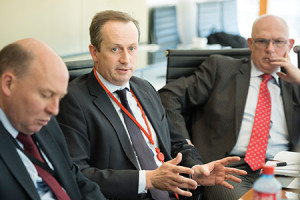
Fintan Slye
We are having those types of discussions with some of our large customers which are connected or are connecting to the grid i.e. how can they connect more green energy? It often fits with their CSR policy objectives and renewable energy is rising up customer agendas. The recent announcement by Apple that it is considering funding renewable energy projects to power its new data centre in Athenry is the most recent tangible example of this.
Brian Motherway
There is a global trend not just towards sustainability but also towards smartening the grid. It is a bit like finding that gold has gone up in value and we happen to have lots of gold – in two forms. One is the renewables resource that means it is cheaper to generate wind power here and the other is that we have that ICT, knowledge and innovation resource that is the ‘gold of the future’. Many of our technology entrepreneurs are now looking to apply their technologies to smarten the grid.
One example is a company in Mayo which makes LEDs for street lights and they have partnered with a data company to make them into a wireless data network. This company, which has invented the technology in Mayo, now deploys hundreds of thousands of these street lights in cities in Florida where they work from a wireless network for utility meter. The street lighting system is now generating more profit than it costs to run. Another example is Glen Dimplex’s Quantum storage heater. No other manufacturer was thinking about how such a device – often seen as low tech – could be used to store energy in a smart grid.
Muiris Flynn
Who knows where the smart grid will take us in terms of business opportunities? We started out working with SSE to solve a particular problem; to create an energy store to accommodate wind energy. Subsequent engagement with EirGrid led us to a deeper understanding of issues such as ancillary services and the opportunity to supply these on the demand side. These initial bilateral collaborations eventually resulted in our Enernet consortium with EirGrid, ESB Networks, SSE, UCD and Intel. We are now working together on a €20 million Horizon 2020 project to demonstrate the value of demand side thermal energy storage. This is a good example of a smart grid application that is resulting in employment in Irish R&D centres and factories.
Fintan Slye
Stepping back 10 years, smart grid was just another word for smart meters. The discourse was dominated by meters. We have moved on with smart meters now seen as only a small part of smart grids – and indeed the boundaries are being pushed in the absence of smart meters.
David Lee
If you Google smart grid, you will find several thousand definitions. I also picked up on the same definition used by Bob as I particularly liked the behavioural aspect of that definition. The technology is there. The challenge is creating an ecosystem via policy and regulation that encourages appropriate investment. Regulators need to encourage utilities to move beyond supporting pilot projects and allow smart grid technologies become mainstream for the regulated utilities.
Bob Hanna
We should have the confidence to do this because we have done it in other areas such as telephone exchanges in which we skipped a generation successfully. I was very excited when we held the EU Presidency in 2013 and the Enernet project was launched and Europe saw the level of co-operation between the system operator and several technology partners.
What are the barriers to be overcome to realise the benefits of smart grids?
Bob Hanna
Regulatory inertia is often the problem with new technologies, although we do have an innovative regulator when compared to other European regulators. Fortunately when we established CER we gave them the role of supporting innovation and R&D. It is now about putting flesh on that so that things like ancillary services are rewarded through tariffs.
Brian Motherway
The real strong magnetic pull is yet to come from consumers. As we have seen in telecoms, the pace of innovation starts when consumers engage and start demanding innovation. When the smart grid is seen as enabling the consumer and not just the industry, it will truly take off with consumers demanding innovation.
John Murphy
We are seeking to understand the various interactions between the relevant regulators to look at the power of dominant players and, in an Irish context, to look at the all-island energy market. If we can establish that, the development of the smart grid can help address that agenda and also meet other policy objectives.
We are also looking to put some meat on the smart grid proposals and one of the disruptive reforms in this year’s Action Plan for Jobs was to create an energy innovation hub. We are also working closely with DCENR to map the research projects that are under way, many of which are supported through Science Foundation Ireland.
Leo Clancy
Installing smart meters at a scale is probably a key enabler. Accelerating the roll-out of the smart meter infrastructure is key and also to ensure that it is two-way from consumers to grid and vice versa. There is a lot of innovation in Ireland but we need to tell the story better. There is a barrier in how well we are known for this, particularly in enterprise circles. Our smart grid dialogue tends to be very Europe-focused but many of the key players are outside Europe.
Fintan Slye
We are not good enough at telling the story. We tend to tell it only at industry fora. It is now about getting that story out there and beyond the island of Ireland. There are some great individual stories with the various pilot projects. We also need to look at the academic research going on and to look at how we co-ordinate it and link it to the industry.
Brian Motherway
Equally we need to tell the story within Ireland. We need to tell all those in society of the good things that are happening and to frame some of those debates that are focused on the negatives based on poor information or narrow interpretations of issues. We need to be talking about future preparedness, job opportunities, better comfort and well-being for citizens.
Muiris Flynn
We have an opportunity to make this a good news story for the consumer. The man or woman in the street doesn’t really understand what the smart grid is. We need to disseminate success stories and real consumer benefits. There is a great opportunity right now at this early stage and we may regret it later if we don’t take it. We need to get into schools and publicise the opportunities presented by a smart grid and how it can enrich peoples’ lives.
What one thing should policy-makers do to accelerate progress?
John Murphy
To frame that vision in language that the political system can get and that can be transmitted to the public and to the regulatory system – and then you can generate support from every sector. You need to capture the imagination of the political system behind a stretched but realisable ambition. At the same time, you need to say: “If you do x, y and z, we will deliver on this ambition for you and it will bring these benefits for Ireland.”
Leo Clancy
Smart meters: putting power in the hands of the consumer. Brian’s comment that four-fifths of energy use is not electricity is really interesting. Increasing the consumption of electricity but reducing the unit costs of consumers is the most powerful thing that smart grids can do for consumers.
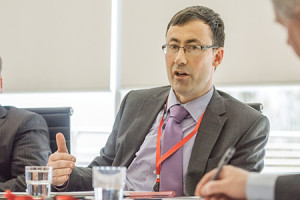
Fintan Slye
If consumers are demanding the technology and the innovation, it will push the industry. That will have to be a holistic story about giving power and control to them, packaged in a way where they are actually ‘pulling’ the control rather than industry pushing it.
Bob Hanna
At the moment, we’ve lost the trust argument with the citizen. It’s fixing that relationship, partly by putting the consumer at the heart of energy policy but also through the bigger picture that we’re all involved in. It’s really about more flexibility about the support mechanisms that are available, more ability to join them up, and more ability to respond to what Europe wants us to do: flexibility and coherence.
Muiris Flynn
Some energy-related policy considers electricity to be a high carbon source of energy. This doesn’t align well with the policy direction of decarbonisation. There is a disconnection in policy that could be usefully addressed.
Brian Motherway
The best first step is to just to get on with delivering things: pilots and deployment of devices and experiments on the ground. Get some apps into people’s phones and homes. Get the factories to do something different. Get the grid to do something different. Rather than trying to solve everything, we have the ability to do more of that tangible delivery on the ground.
David Lee
In other countries the technology has not been the main barrier to adoption, it has been the engagement of the customer and both have to be done in parallel. The behavioural element of the smart grid is very important.

